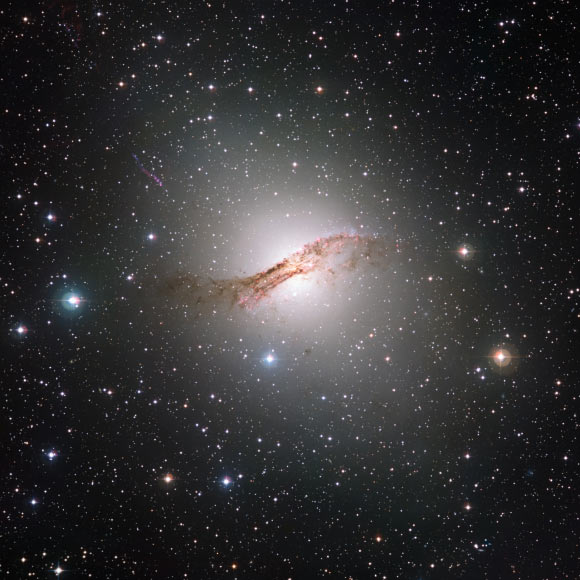An international group of astronomers using ESO’s Very Large Telescope at the Paranal Observatory in northern Chile has discovered a never-seen-before kind of star clusters around a giant galaxy known as NGC 5128.

The giant elliptical galaxy Centaurus A (NGC 5128) is the closest such galaxy to the Earth, at a distance of about 12 million light-years. Image credit: ESO / ESA / Hubble / NASA / Digitized Sky Survey / Davide de Martin.
NGC 5128, also known as Centaurus A, is a huge elliptical galaxy located in the constellation Centaurus, approximately 12 million light-years away.
It is the closest giant galaxy to our home Milky Way Galaxy and is suspected to harbor as many as 2,000 globular star clusters. Many of these objects are brighter and more massive than the 150 or so orbiting the Milky Way.
“Globular clusters and their constituent stars are keys to understanding the formation and evolution of galaxies. For decades, astronomers thought that the stars that made up a given globular cluster all shared the same ages and chemical compositions – but we now know that they are stranger and more complicated creatures,” said Matt Taylor, a PhD student at the Pontificia Universidad Catolica de Chile, who is the first author on the study accepted for publication in the Astrophysical Journal (arXiv.org preprint).
Taylor and his colleagues from Chile and the United States have made the most detailed studies so far of a sample of 125 globular star clusters around NGC 5128 using the FLAMES instrument on ESO’s Very Large Telescope.
They used these observations to deduce the mass of the clusters and compare this result with how brightly each of the clusters shines.
For most of the clusters in the survey, the brighter ones had more mass in the way that was expected if a cluster contains more stars it has greater total brightness and more total mass.
But for some of the globulars something strange showed up: they were many times more massive than they looked.
And even more strangely, the more massive these clusters were, the greater the fraction of their material was dark. Something in these clusters was dark, hidden and massive.
According to Taylor’s team, these newly-discovered objects – dubbed ‘dark’ globular star clusters – may either harbor unexpected amounts of dark matter, or contain massive black holes – neither of which was expected nor is understood.
“Our discovery of star clusters with unexpectedly high masses for the amount of stars they contain hints that there might be multiple families of globular clusters, with differing formation histories,” said co-author Dr Thomas Puzia, also from the Pontificia Universidad Catolica de Chile.
“Apparently some star clusters look like, walk like, and smell like run-of-the-mill globulars, but there may quite literally be more to them than meets the eye.”
Taylor added: “we have stumbled on a new and mysterious class of star cluster. This shows that we still have much to learn about all aspects of globular cluster formation. It’s an important result and we now need to find further examples of dark clusters around other galaxies.”
_____
Matthew Taylor et al. 2015. Observational Evidence for a Dark Side to NGC5128’s Globular Cluster System. ApJ, accepted for publication; arXiv: 1503.04198







